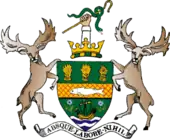Portaferry
Portaferry (from Irish Port a' Pheire 'landing place of the ferry') is a small town in County Down, Northern Ireland, at the southern end of the Ards Peninsula, near the Narrows at the entrance to Strangford Lough. It is home to the Exploris aquarium and is well known for the annual Gala Week Float Parade. It hosts its own small Marina, the Portaferry Marina. The Portaferry - Strangford Ferry service operates daily at 15-minute intervals (8am to 11pm) between the villages of Portaferry and Strangford, less than a mile apart, conveying about 500,000 passengers per annum. It had a population of 2,514 people in the 2011 Census.[1]
Portaferry
| |
|---|---|
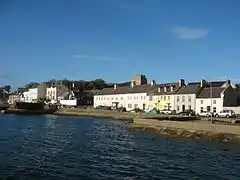 Portaferry from the pier towards the north | |
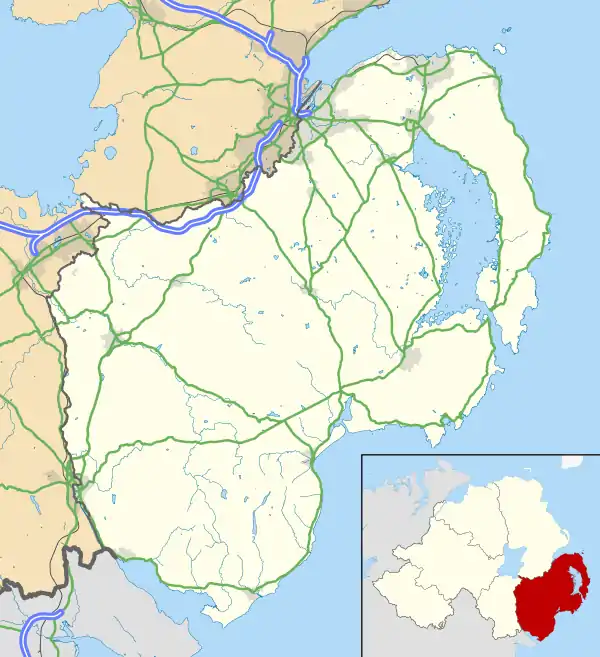 Location within County Down | |
| Population | 2,514 (2011 Census) |
| Irish grid reference | J594509 |
| District | |
| County | |
| Country | Northern Ireland |
| Sovereign state | United Kingdom |
| Post town | NEWTOWNARDS |
| Postcode district | BT22 |
| Dialling code | 028 |
| Police | Northern Ireland |
| Fire | Northern Ireland |
| Ambulance | Northern Ireland |
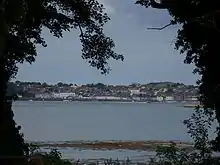
Pot fishing, mainly for prawns and crabs and licensed shellfish farming takes place within Strangford Lough. Queen's University of Belfast[2] have a Marine Research Laboratory on the shorefront and currently the town is also home to a tidal energy research project the Minesto Sea Kite. The Lough is one of the world's most important marine sites with over 2,000 marine species.
There are fine Georgian buildings in the town square, including a Market House, now used as a community centre.
Portaferry Lifeboat is an essential lifeline for local fishermen and yachtsmen. In 1987 a lifeboat house was built aided by money raised through the Belfast Newsletter's Lord Louis Mountbatten Appeal Fund. In 1994 a new Atlantic 75 inshore lifeboat, also named 'Blue Peter V', replaced the Atlantic 21. The Atlantic 75 is the fastest seagoing lifeboat in the RNLI's fleet and is capable of speeds up to 34 Knots.[3][4]
History
In the 17th century Ulster ports began to rise in prominence. In 1625 William Pitt was appointed as Customer of the ports of Newcastle, Dundrum, Killough, Portaferry, Donaghadee, Bangor and Holywood.[5]
Demography
2001 Census
Portaferry is classified as an intermediate settlement by the NI Statistics and Research Agency (NISRA) (i.e. with population between 2,250 and 4,500 people). On Census day (29 April 2001) there were 2,467 people living in Portaferry. Of these:
- 25.1% were aged under 16 years and 18.2% were aged 60 and over
- 50.4% of the population were male and 49.6% were female
- 89.1% were from a Catholic background and 9.7% were from a Protestant background
- 4.6% of people aged 16–74 were unemployed.
Places of interest
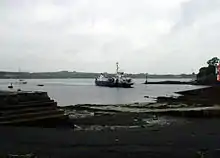
- Portaferry is the home of the Northern Ireland Aquarium – Exploris.[6] It was opened by Ards Borough Council in 1987 and extended and re-opened by Prince Charles in 1994 as Exploris. It is now under private management . It is Northern Ireland's premier seal sanctuary and aquarium, featuring a huge walk-through tank and outdoor seal pools.
- Transport NI an executive agency of the Department for Infrastructure (Northern Ireland) operates a car ferry service across Strangford Lough between the villages of Strangford and Portaferry. To travel the distance between Strangford and Portaferry by road is approximately 75 kilometres and takes about an hour and a half by car. By contrast, the ferry route is approximately 0.6 nautical miles (1.1 km) with a typical crossing time of about 8 minutes.[7]
- Portaferry Castle is a small 16th-century tower house built by William Le Savage.[8] It is a square building with a small projecting turret at the south corner. It is three storeys high plus attic. There is no vault. Most of the eastern corner is ruinous.
People
- Bishop Robert Echlin, Bishop of Down and Connor (1612–1635) is buried in the ancient ruins of Templecraney, Portaferry off Church St.
- Actor and playwright Joseph Tomelty, born in Portaferry in 1911.[9]
- Priest, philosopher and poet Father Vincent McNabb was born in Portaferry.
- Middle-distance runner Ciara Mageean was born in Portaferry in 1992.
- Singer/songwriter Ryan McMullan is from Portaferry.
Environment
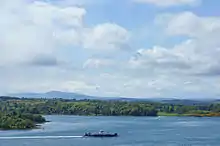
The Portaferry area is popular with local and foreign tourists for its beauty, history, wildlife and other visitor attractions. Strangford Lough is the largest sea inlet in the British Isles.
It is Northern Ireland's first Marine Nature Reserve and is renowned as an Area of Outstanding Natural Beauty and Special Scientific Interest, with six National Nature Reserves within its reaches. Over 2000 species of marine animals have been found in the Lough and internationally important flocks of wildfowl and wading birds converge there in winter. The Lough is also the most important site in Ireland for breeding common seals.
Sport
GAA sports, particularly hurling are popular in the area and Portaferry GAC were Ulster Club Hurling Champions in 2014. There are two other GAA clubs nearby, Ballygalget and Ballycran, and there is intense rivalry between the three.
Other pursuits are sailing, coastal rowing, angling, wildfowling and birdwatching. The town has the Lough's longest established sailing club.
Industry
Portaferry industrial activities include agriculture, fishing, tourism. 'Suki Tea' announced as of 2014 that experimental tea growing will commence in the area, utilising the relatively warm and dry climate, with frost protection from Strangford lough. The Lough is a centre for experimental marine current turbine technology development. In 2008 a twin rotor 1.2 MW SeaGen was installed and successfully demonstrated this technology until its decommissioning which began in 2017. Tidal energy, unlike wind or wave, is a renewable energy resource which can be predicted.[www.marineturbines.com]. Swedish company Minesto are currently trialling their "sea kite" technology.
Portaferry played a part in the linen industry. Many of the women in the town were employed to embroider handkerchiefs for Thomas Somerset and Co. one of the major linen companies in Ireland. The company realised that the women were more productive in the summer due to the light, so installed the first electric light outside of Belfast in Ulster. Each house with a working woman was given one light fitting and bulb. There was also a bus service introduced to bring more women from the Ards Peninsula to Portaferry to work in the factory that Somersets built.
Gallery
 Portaferry from the pier towards the south
Portaferry from the pier towards the south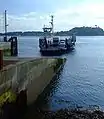 The Portaferry ferry returning from Strangford.
The Portaferry ferry returning from Strangford. Portaferry Marina.
Portaferry Marina. Portaferry Castle.
Portaferry Castle. Portaferry from the pier towards the north
Portaferry from the pier towards the north Portaferry From Castleward.
Portaferry From Castleward.
See also
References
| Wikimedia Commons has media related to Portaferry. |
- "Portaferry". Census 2011 Results. NI Statistics and Research Agency. Retrieved 22 April 2015.
- Marine Laboratory Archived 2 February 2006 at the Wayback Machine
- Portaferry Lifeboat
- Culture Northern Ireland – Portaferry Lifeboat Station Archived 17 March 2007 at the Wayback Machine
- O'Sullivan, Aidan & Breen, Colin (2007). Maritime Ireland. An Archaeology of Coastal Communities. Stroud: Tempus. p. 211. ISBN 978-0-7524-2509-2.
- Exploris
- "About the Ferry". Northern Ireland Roads Department. Archived from the original on 7 December 2009. Retrieved 13 September 2009.
- Portaferry Castle Archived 4 May 2005 at the Wayback Machine
- Culture Northern ireland – Joseph Tomelty Archived 21 March 2007 at the Wayback Machine
